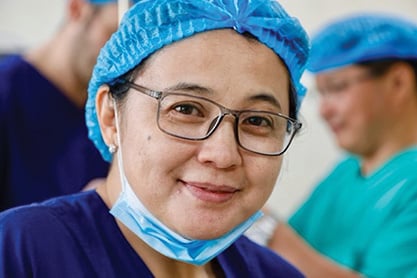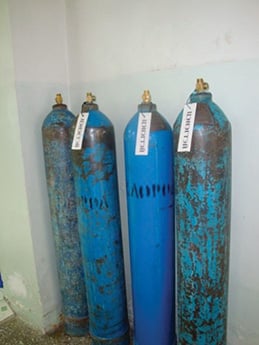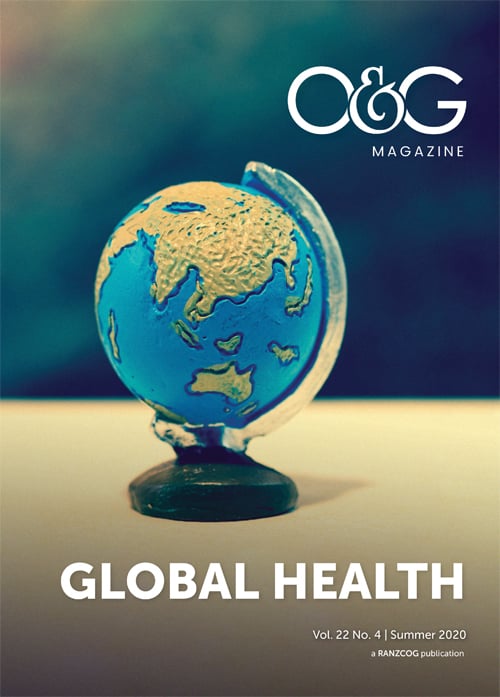In 2009, we were invited by our anaesthetic colleagues to join them on their annual trip to Mongolia to see if we could help establish a laparoscopic gynaecology service. Our knowledge of the country was so limited that we had to conduct internet searches to find out some basic facts about the country, including the capital city Ulaanbaatar (known to everyone as ‘UB’). We could have little idea how this would evolve over the following 12 years.
Mongolia had previously been under Soviet-backed communist leadership from 1924 and was known as the Mongolian People’s Republic. The country achieved independence after a peaceful democratic revolution in 1990. They had no formal medical system until the 1920s.
We knew that one of our senior colleagues, Dr Jeffery Tan, had travelled there several times in the 1990s to provide gynaecological training and support for local doctors. Our first trip began with what seemed to be a straightforward request to perform the very first laparoscopy at the First Maternity Hospital. As the day unfolded, we were to become aware of what an ordeal teaching new surgical techniques would become.

Dr Davaajav Unurjargal.
We were presented with a room full of donated overseas equipment in various degrees of working order, and a gynaecologist who had spent a year preparing for the day when her hospital would allow her to perform a diagnostic laparoscopy. Dr Unurjargal (known to all as ‘Unur’) had spent a total of six months training in Thailand and France to prepare herself and had procured, from several charitable sources, the ‘laparoscopic stack’ and associated equipment. She told us that she had secured a cylinder of CO2 from the ‘black market’, and when we asked how she knew that it was CO2, she replied, ‘because it’s written on the cylinder in texta’.

CO2 cylinders.
Unur’s English language skills were sufficient for us to communicate (she was also fluent in Russian and French), yet she was also acting as translator for everyone else in the theatre. There were at least 30 people in the theatre including anaesthetists, ‘biomedical engineers’, nurses, hospital administrators and gynaecologists. We were fortunate to have an Australian anaesthetist, experienced in general anaesthesia for laparoscopic surgery, as we had been told that laparoscopies had only been performed at other hospitals under spinal anaesthesia. The landmark event took just over four hours (the diagnostic laparoscopy revealing a normal pelvis, much to our delight) and was deemed a success. We later discovered we had made the local television news. This style of teaching, with language difficulties and multiple translations has been a hallmark of our challenges with teaching and learning.
After this initial successful trip came a welcome invitation for future visits. We were aware that other foreign doctors and organisations had visited at different times, but what was clearly lacking was a co-ordinated approach to this aid, and its success was highly dependent on the motivation, medico-political connections and language skills of the doctors at the various hospitals. The First Maternity Hospital had received many well-intentioned donations of medical and surgical equipment from overseas, but lacked the skills and resources to use and maintain the equipment. We were, for example, surprised to see a collection of ‘Harmonic Scalpels’ in a cupboard, but no sign of the (expensive) unit to drive them.
What has become evident to us is that Dr Unurjargal is the ‘local champion’ for improving healthcare for women in UB. She had a clear vision for expanding the services available in her hospital and had the support of those around her to enable change. This has been the key to our ongoing success and allowed us to move forward.
In 2011, Dr Unurjargal, with the help of the WHO, organised the first laparoscopic training centre, with a dry lab and video links to theatre so that the participants could watch simple laparoscopic procedures and practise simple laparoscopic skills. The opening was televised on Mongolian TV, so we were instant celebrities. Each year we have been able to introduce something new, but also help build on skills they were already integrating into their practice.
We hosted the first ‘live animal laparoscopic surgery training’ lab in Mongolia in 2012. We organised and ran the first hysteroscopic workshop in Mongolia in 2018, with participants happily resecting peeled grapes with a bipolar resectoscope. In 2019, we held their first gynaecological cadaveric workshop.
This has now become an annual visit for two weeks each year in the Mongolian summer by a diverse group of self-funding doctors including O&Gs, anaesthetists, neonatologists and GPs as well as peri-operative nurses, midwives and biomedical engineers. The 12–15 team members co-ordinate their diaries and develop complimentary teaching and education programs that aim to provide education and support to our colleagues in a low-resource country. Some volunteers have been able to travel each year, and some have joined us for one or two trips, but each contribution has been highly valued.
Over the 12-year period, we have refined our understanding of cultural awareness and sensitivity. Our relationship perhaps began like many others in the form of ‘medical tourism’ but has developed into a much deeper collaboration based on trust (that we will continue the connection) and exchange of ideas rather than the concept of us providing donated equipment or making changes that are not effective or realistic once we depart.
In 2018, Drs Samantha Hargreaves, Emma Readman, Kym Jansen and Phil Popham (anaesthetist) were presented with the Silver Friendship (Nairamdal) Medal by the Mongolian president, the highest honour bestowed upon a foreign citizen by the Mongolian Government, for their contributions to strengthening the collaboration between their country and Mongolia through their work.

Four Australian doctors receiving Silver Friendship medal (Nairamdal). From left: Dr Davaajav Unurjargal, Dr Philip Popham, G.Bayasgalan, Dr Kym Jansen, Kh.Battulga (Mongolian President),Dr Emma Readman, Dr Samantha Hargreaves, Z.Munkh-Od.
For the last four years, and with the exclusive financial support of The Epworth Foundation, we have also included a scholarship program for two Mongolian doctors who are able to spend three months as observers in Australian public and private hospitals in Melbourne, with visits planned to New Zealand in the future. This has been a popular and highly sought-after scholarship by doctors of all levels in Mongolia.
Whilst in Mongolia for two weeks, we are able to provide education and support in many areas:
- Gynaecology: in particular supporting minimally invasive gynaecological surgery and women’s health.
- Obstetrics: has focused on simulation-based training and emergency obstetrics.
- Perioperative nurses: have introduced and continue to reinforce WHO ‘time-out’ checklists and documentation, instrument and pack counting and safe sharps handling.
- Anaesthetics: have focused on laparoscopic surgery and obstetric anaesthesia. The communication between individuals and teams in a surgical setting is demonstrably different in different cultures but underpins our discussions with the Mongolians in terms of improving patient safety and outcomes. We are able to continue these teaching efforts by short video presentations as well as our presence in the operating theatre with one-to-one teaching.
- Neonatologists: provided training in neonatal resuscitation and management of common neonatal problems such as jaundice and sepsis.
- Biomedical Engineering: there was huge demand for maintenance and repair of medical equipment, some of which was donated but lacked local power connections or fittings to enable use. One example was a phototherapy unit which was in working order but lacked the correct mains plug. The sterilisation unit in theatres at the First Maternity Hospital had been unusable for some of 2019 and required a spare part that was not accessible until our biomedical engineer was able to source it.
Primary care in Women’s Health is an area to which we have limited access since our exposure is mainly hospital-based health care. There are many cultural and political constraints and differences that we are only now beginning to understand. The cultural significance of their isolation as a country, and individual physical isolation in a vast and sparsely populated country with extremes of weather is something that we continue to learn about with each trip.
Our visits are based around The First Maternity Hospital, which is the busiest obstetric unit in Ulaanbaatar with about 13,000 deliveries each year. We then travel with the team from First Maternity hospital to the most remote regional areas where they have requested our input and support.
We have been able to demonstrate and enact the concept of ‘Train the Trainer’, particularly when going to visit the remote regional centres. We now have a more supervisory and observational role. This model has worked extremely well from a language and cultural perspective.
Regional junior doctors also have the opportunity to apply for a three-month rotation to UB to learn further laparoscopic skills; however, it is clear that this model of exchange is of short duration and is inadequate to build enough expertise to develop a laparoscopic service outside a major city.
We have set up an organisation in partnership with the Mongolian doctors, The Mongolian Australian Medical Affiliation (MAMA). Through this entity, and with the national recognition that the Silver Peace Medal has provided, we now hope that we are in the next phase of our collaboration with the Mongolian O&G community.

The Mongolian and Australian team.
We are planning to become involved in training the O&G community more broadly, perhaps by developing locally appropriate training workshops, and focusing on surgical culture training and history taking skills. We are also providing them with an audit tool to help their and our understanding of surgical requirements.
Unfortunately, it is highly likely that the COVID-19 pandemic will set back the progress we have been making in Mongolia. Mongolia has had less than 300 cases and no deaths but is vulnerable to the pandemic, not only because of its proximity to China and Russia, but also due to its own inadequate healthcare system.
From our point of view, we have learnt a lot about ourselves as Australian medical professionals. We have found that going away with a group of people with similar goals and outlooks can give insight but also deep friendship. We have also developed a real appreciation for our different skillsets, and that has given us trust between ourselves which has continued back in Australia.
Finally, we have learnt as much medically as they have. This sounds like a cliché, but it is completely true. Their capacity to adapt and use fewer resources is very important for us to see. They are also very happy to trial new things that have pushed us to the edge of our comfort zones, which is great. It is a true collaboration.






Leave a Reply